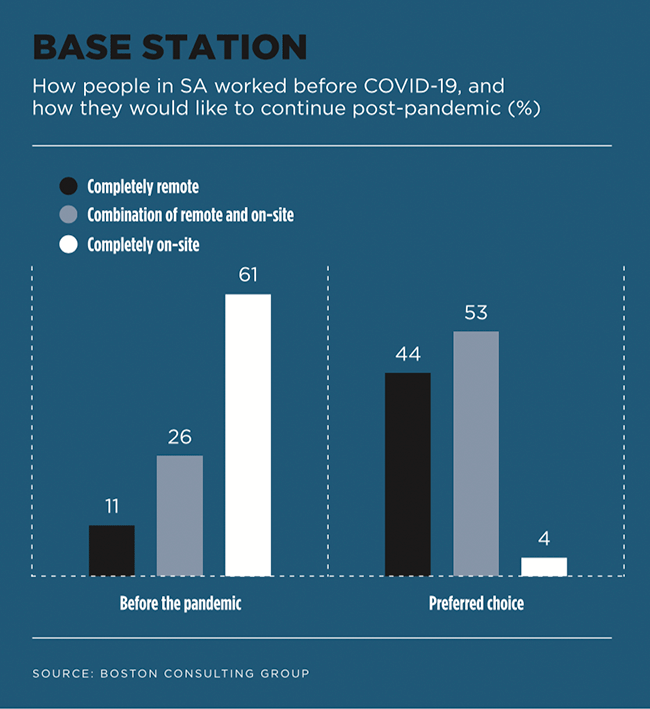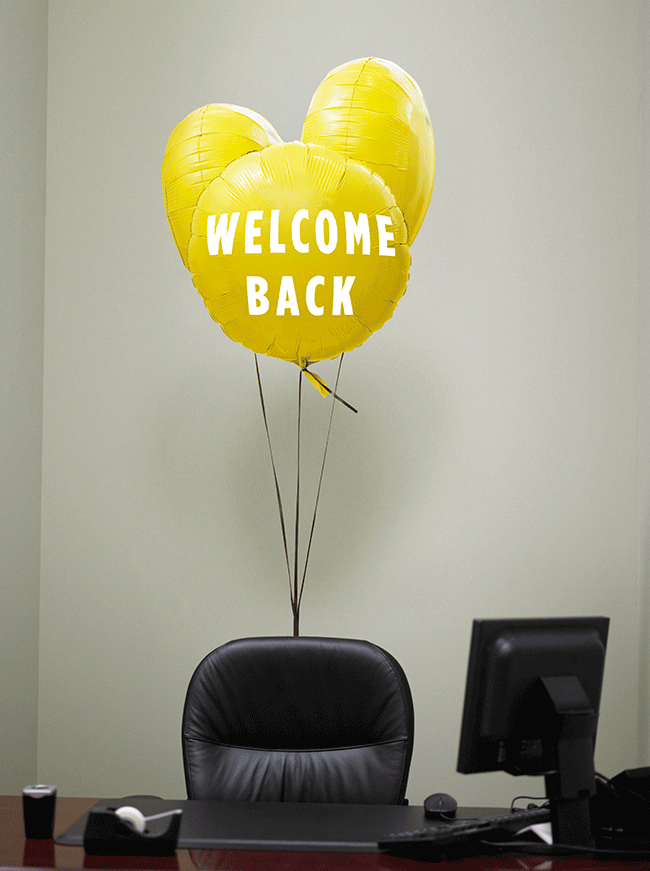If finance giants such as Deutsche Bank, HSBC and Citigroup are getting behind a hybrid work model, with one even saying its big bosses would trade their plush offices for hot-desking with colleagues, does that signal the end of the traditional office as we know it? And is creating the ideal office environment that suits everyone actually possible?
What’s certain is that company heads and HR executives face a tough job if they want to maintain a strong company culture, rewarding collaboration opportunities and ensure job satisfaction without sacrificing those all-important business outcomes – productivity, staff retention and, of course, profit.
Never mind the fact that everyone has an opinion about how to do it best, with global research suggesting that while the majority of workers believe the desk is indeed dead, there are still many among them who cannot wait to escape home environments fraught with competing responsibilities.
For the hybrid model to succeed, it’s up to executive teams and managers to ensure a smooth transition. And for that, they’ll require new skills, while also rapidly fine-tuning those acquired by default during the pandemic, when businesses across the globe made that abrupt shift to remote working. Practically, however, just how easy it is to achieve this delicate balance?
Dimension Data staff, for example, were reported to be required to book the days they intended to be in the office via an online portal, to ensure numbers were controlled in the workplace and that strict physical distancing could be maintained. Cape Town-based asset manager Prescient Investment Management, meanwhile, requires staff to spend at least three days a week in the office, according to a Business Insider article. In May, Google chief executive Sundar Pichai announced that the company expects 60% of its approximately 140 000 global employees to spend around three days per week in the office post-pandemic. Pichai said the majority of staff would come into the office ‘a few days a week’, and 20% were expected to work from home permanently, while another 20% would work from new office locations.
Beyers Müller, CEO of flexible-workspace provider the Workspace, explains in an online article that a hybrid workplace, in effect, is one that combines remote work and work in a traditional office space. For example, one staffer may work remotely for three days a week. Another might work from home full-time, but attend meetings at the office, or come in for briefings as necessary.

‘More and more, the internet is the workplace for a large sector of the workforce. This has made the transition to remote work a logical one,’ he writes, adding that this does not, however, mean that the traditional office space has lost its value entirely. ‘Instead, its purpose is evolving.’
And employees appear to overwhelmingly support the concept, wherever in the world they may be. The results of a study released in April by WeWork and Workplace Intelligence, an HR research and advisory firm, revealed that in the US employees and C-level executives alike are in favour of a hybrid approach. Of the employees, 75% indicated they would give up at least one benefit or perk for the freedom to choose their work environment. And, if their roles allow for it, 79% of the C-Suite respondents said they plan to let their employees split their time between corporate offices and remote working. In fact, 76% said they were likely to give their staff a stipend to work from home or a coworking space.
The survey also revealed a link between hybrid work arrangements and employee satisfaction, engagement and the likelihood that they would recommend their company to others.
Closer to home, 53% of SA respondents in an international study said their future preference would be for a job that allows them to work from home, at least occasionally. SA also emerged as one of the countries that would embrace fully remote work, with 44% (against a global average of 24%) reporting that they want to work entirely remotely.
The study by Boston Consulting Group and the Network, co-operating locally with CareerJunction, included more than 200 000 participants in 190 countries, nearly 1 500 in SA. According to a BizCommunity report on the study, ‘South Africans in digital, knowledge, and office jobs in particular – many of whom are already working remotely – want more workplace flexibility on a permanent basis, and would even consider going fully remote. Marketing and communication leads the charge, with 62.5% saying they would move to a fully remote mode of working. In total, 61% of South African respondents would like some or full flexibility in defining their working hours’, which is in line with the global average.
‘The pandemic has significantly changed how people think about their work and mobility preferences, because many had to transition to remote work basically overnight,’ says Rudi van Blerk, principal and recruiting director at Boston Consulting Group. ‘Workers and managers alike have seen that flexible work models are possible and, in fact, desirable, with only 4% of South Africans saying they would want to return to working completely on-site at an office after the pandemic.’
So if the old tradition of clocking into the office for a 9-to-5 shift is indeed a relic of the past, is there a best-practice model for this new, flexible working arrangement, or are bosses beating a new path they just hope will end up working? The Workspace’s Müller identifies more positives than negatives for this office reality. The pros include higher levels of job satisfaction, increased productivity (contrary to expectations), lower operational costs for companies and employees who are more content. For instance, as an employee living in Johannesburg, he notes, ‘that equates to saving five days per year, the length of time the typical commuter spends stuck in traffic’.

On the downside – and companies will certainly have to pay close attention to these – Müller lists increased investment in technology to support remote workers, a potentially diminished customer experience without the usual face-to-face interactions, and the costs associated with realigning and re-equipping your office space so you can smoothly transition to a new world of online interaction.
In an article published on CHRO South Africa, Sigrid Müller, Standard Chartered Bank head of HR for South and Southern Africa, says a hybrid model can keep employees connected – whether they’re in the office or working remotely – if it is fully supported by strategic planning and technology. ‘To build an inclusive hybrid culture, it is critical to place the remote worker at the centre of all company activities,’ she adds. ‘Transparent and frequent communication [from leaders] will help employees be engaged and be part of the team. Looking at new ways of working that listen to the needs of employees will help maintain morale, and improve it.’
US-based HR executive Sarah Grimstead, writing for Fast Company, echoes that sentiment, but adds that workplace fairness must also be a key consideration. ‘With some workers in-person and others remote, leaders must ensure all employees have access to the same resources and opportunities,’ she says. ‘If not, some workers may feel excluded, causing disengagement, unhappiness or even employee turnover.’ Supervisors, she cautions, will naturally interact more frequently with in-office staff, potentially overlooking remote employees in comparison. So it’s a bit of a tightrope, and to keep everyone happy they’ll have to walk it with skill and assurance. Otherwise, disparities ‘can have broad consequences for employees and for business performance’.
In a column for Forbes, Laurel Farrer, remote work strategist and president of the Remote Work Association, a global professional association for virtual business leaders, also advises companies against taking any shortcuts in the process. They cannot simply continue operating as they did in the early days of the pandemic, she writes.
‘In the early days of the pandemic, working from home was implemented as a temporary contingency plan – a haphazard bandage wrapped around operations to prevent halted productivity and output from bleeding the company to death,’ says Farrer, adding that the emergency bandage plan is no longer acceptable. ‘Companies [need to] upgrade their temporary workplace flexibility plan into a comprehensive virtual organisational model that includes updates to infrastructure, protocols, and employee experience. ‘So, while organisations around the globe rush to return to their workplaces, perhaps there is an even more exciting opportunity to not just revive the humans of the workplace, but humanity, if leaders construct a new business world based on flexibility that transcends the cubicle.’








